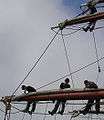Sheet (sailing)
In sailing, a sheet is a line (rope, cable or chain) used to control the movable corner(s) (clews) of a sail.
Etymology
"sheet" is an expanse or surface, flat and thin, of various materials; or a rope attached to a sail.[1][2]
These two apparently widely separated meanings are to be explained by the generally received etymology. In O. Eng. there are three words, all from the root seen in "shoot", to dart, let fly, thrust forward; scete or scȳte, a sheet of cloth, sceat, corner or fold of a garment, projecting angles, region (e.g. sæs scädt, portion of the sea, gulf, bay), and scēata, foot of a sail, pes veli (Wright, Gloss). The original meaning, according to Skeat, is “projection,” or that which shoots out, then a corner, especially of a garment or of a cloth; after which it was extended to mean a whole cloth or "sheet".[1]
In Icelandic, the cognate word skaut has much the same meanings, including that of a rope attached to a sail. Other cognate forms in Teutonic languages are Ger. Schoss, lap, bosom, properly fold of a garment, Dutch school, Icel. skaut, &c.[1]
In current English usage, "sheet" is commonly applied to any flat, thin surface, such as a sheet of paper or a bed sheet.[1]
In nautical usage the term "sheet" is applied to a rope or chain attached to the lower corners of a sail for the purpose of extension or change of direction. The connexion in derivation with "shoot" is more clearly seen in "sheet-anchor", one that is kept in reserve, to be "shot" in case of emergency.[1][3]
Fore-and-aft rigs
Fore-and-aft rigs comprise the vast majority of sailing vessels in use today, including effectively all dinghies and yachts. The sheet on a fore-and-aft sail controls the angle of the sail to the wind, and should be adjusted to keep the sail just filled. Most smaller boats use the Bermuda rig, which has two or three sets of sheets:
- The mainsheet is attached to the boom, and is used to control the mainsail. In a rig with no boom on the mainsail, the mainsheet would attach directly to the mainsail clew. A mainsheet is a rope connected to the boom which allows a sailor to control the speed of a boat.
- The jib sheet attaches to the clew of the jib, and controls it. The jib has a sheet on each side, only one of which (the leeward one) will be in use at one time.
- The spinnaker sheet attaches to the clew(s) of the spinnaker, if carried. A symmetrical spinnaker has two sheets, an "active" one and a "lazy" one, in the same way as a jib, but they are attached to the sail's two separate clews. On boats larger than around thirty feet, the spinnaker will also be fitted with guys, which are similar to sheets but control the pole instead of the sail. On smaller boats the lazy sheet is used as a guy.
On the smallest boats, a sheet is often a simple rope, pulled by hand; on larger boats, usually on the mainsheet, it is often a system using several blocks to provide mechanical advantage. At one time, headsail sheets on yachts also involved blocks, but the disadvantages of having large amounts of line and loose blocks free to move all over the forward part of the vessel mean that such systems have been almost universally replaced with single-line sheets holding immense forces but controlled by powerful winches.
Square rig
Square-rigged vessels are much less common, and are usually large ships. Nevertheless, they too have sheets on the movable corners of their square sails. Unlike fore-and-aft sheets, though, square-rig sheets do not control the angle of the sails (which is performed using braces); instead, they are used to haul the corners of the sails from their stowed positions down towards the tip of the yard below. They are then not adjusted significantly while sailing until the sail is to be handed (put away) again. The lowest sails, the courses, are trimmed using the sheets as these sails are loose footed and are secured to yards only at the head.
 Coiled sheets
Coiled sheets The length of chain running diagonally up and right from the bottom-left of this picture to the upper of the two yards is the fore-lower-topsail sheet. Some of the lines on Prince William 's larger sails are made of chain to handle the heavy loads while remaining flexible enough to pass through the various blocks on their route to the deck.
The length of chain running diagonally up and right from the bottom-left of this picture to the upper of the two yards is the fore-lower-topsail sheet. Some of the lines on Prince William 's larger sails are made of chain to handle the heavy loads while remaining flexible enough to pass through the various blocks on their route to the deck.
References
- 1 2 3 4 5

- ↑ "sheet, n.2" in Oxford English Dictionary.
- ↑
